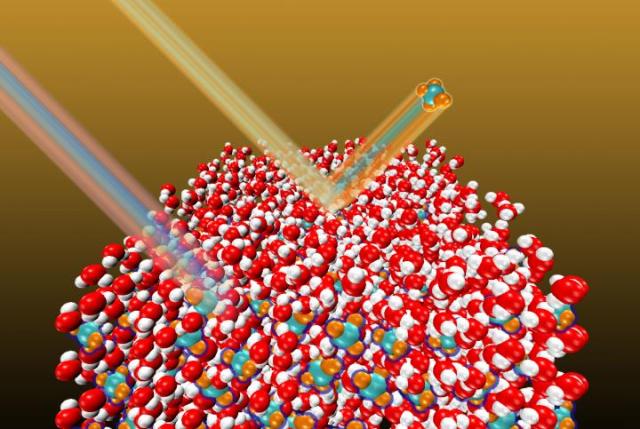Oct 1 2014
 This illustration shows energetic gas phase molecules interacting with an ice surface, including the channel by which high-velocity molecules directly embed beneath the surface. (Credit: Grant Langlois, Wenxin Li/University of Chicago)
This illustration shows energetic gas phase molecules interacting with an ice surface, including the channel by which high-velocity molecules directly embed beneath the surface. (Credit: Grant Langlois, Wenxin Li/University of Chicago)
A new mechanism called “stable energetic embedding” of molecules and atoms within ice surfaces has been discovered by a group of scientists from the Loyola University and University of Chicago.
The interaction and trapping of molecules, such as carbon tetrafluroide, within ice surfaces can be explained with this newly discovered mechanism. The researchers also explained how molecules and atoms embedded into the surface of ice remain trapped even at temperatures higher than the typical desorption temperature of surface-adsorbed molecules.
According to Steven J. Sibener, one of the researchers, the research team elucidated the penetration depth of gas into the ice surface by demonstrating that the molecules remain trapped in the subsurface region instead of diffusing freely all across the ice surface at the experiment temperature.
High purity ice films are grown on a cryogenic substrate under an ultrahigh vacuum environment so that the researchers can control the formation of the ice films accurately by adjusting the water deposition rate at a range of substrate temperatures.
Two forms of ice have been created by the researchers, namely amorphous and crystalline solid water, said Sibener. Increasing the temperature to 160K can transform the amorphous form into crystalline form. After this preparation, the ice surface is subjected to a supersonic beam carrying atoms or molecules, he added.
A stream of monoenergetic species is then created using supersonic beam techniques. The collision of these monoenergetic species with the ice surface follows a specified geometry. Using these distinct collision kinematics, the researchers are able to theoretically simulate the mechanism behind the trapping of the molecules into the ice film and gain insights into energy transfer and sticking probabilities through quantification of the angular distributions and velocity of the reflected species, explained Sibener.
Sibener went on to say that the detection of the embedded molecules is done with the help of highly sensitive in situ glancing angle infrared spectroscopy and post-dosing thermal desorption. The study findings hold potential to create more comprehensive models of accretion and composition of ice in space environments, he concluded.
The study results have been featured in The Journal of Chemical Physics.